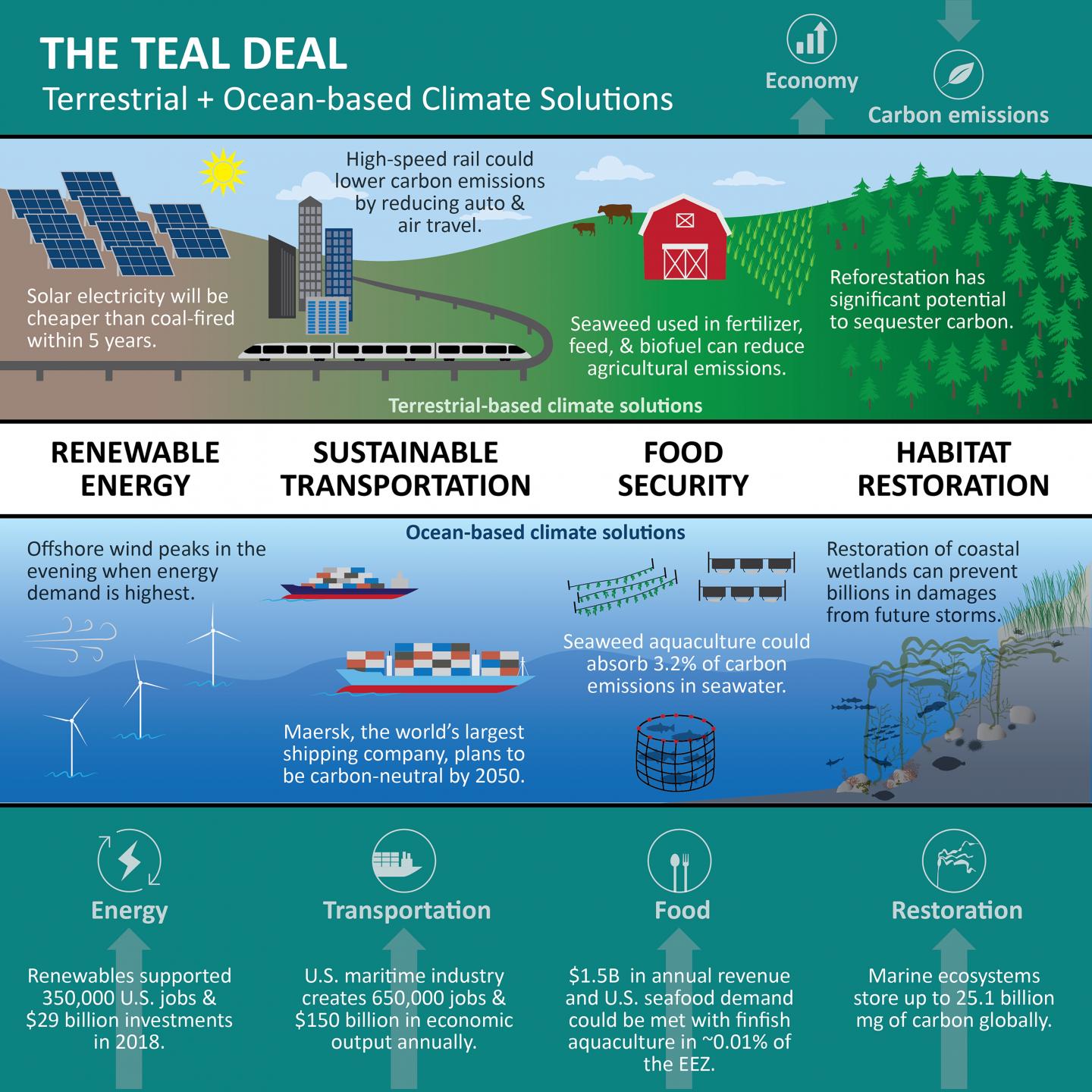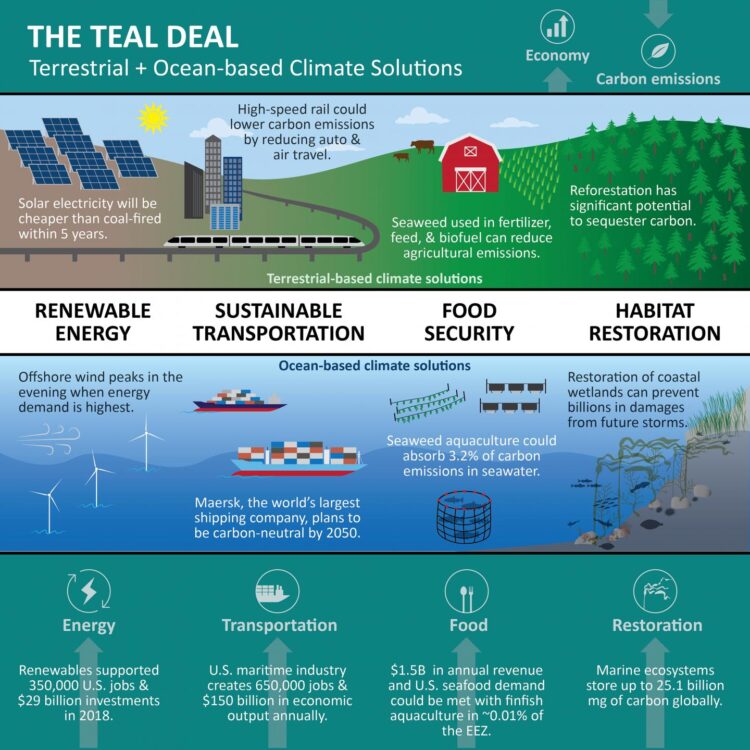Incorporating the oceans into climate policy is essential, scientists say in a new paper

Credit: Authors of the paper
Debates around the Green New Deal have largely centered around climate change concerns on land. But a group of scientists are calling on policymakers to include oceans in the deal.
The Green New Deal is a legislative proposal to tackle climate change and boost the economy, while also supporting equity and social justice.
“There is an opportunity to enact policy that can make meaningful change to help our country both economically and environmentally,” said San Diego State University ecologist Rebecca Lewison, one of the co-authors of a new paper on the subject. “It’s critical that oceans are part of that policy framework.”
“Integrating Oceans into Climate Policy: Any Green New Deal Needs a Splash of Blue” was published in April in Conservation Letters. Lead authors are Lewison, whose work focuses on sustainable resource and land use, and Arielle Levine, an SDSU geographer specializing in human-environment interactions in marine and coastal systems, in collaboration with Oregon State University environmental economist Steven Dundas.
The authors recommend a policy that integrates terrestrial and ocean approaches to create a robust portfolio of climate adaptation and mitigation measures supporting communities, the environment and the economy.
“As we come out of this pandemic, policymakers will be looking for ways to jump start the economy, and we have a unique opportunity to develop policies that promote economic development in an environmentally sustainable manner,” Levine said. “Including the oceans in Green New Deal policies will expand opportunities for sustainable economic development in both inland and coastal communities, while addressing the ongoing threat of climate change that we can’t ignore.”
Their proposals focus on renewable energy, sustainable transportation, food security and habitat restoration, and include:
Harnessing offshore energy
A push to expand offshore renewables will complement the push for renewable energy on land, the scientists said. As ocean winds pick up in the evening, they can supplement energy sources especially during the critical evening peak hours from 4 to 9 p.m.
“Developing offshore renewable energy will help states build a stronger, more adaptable and sustainable energy portfolio,” Lewison said.
Reducing emissions from ships, freighters, ports
As with energy, climate-ready sustainable transport can and should include maritime shipping, since more than 80% of global merchandise travels by sea and ships are responsible for about 3% of greenhouse gas emissions.
Reducing ship speed is one measure that can reduce emissions. This will mean it takes ships longer to reach destinations, but it’s a strategy shipping companies already use voluntarily when fuel prices are high.
“Policies to reduce speed, modifications to ship design and improved fuel efficiency standards for new ships can help significantly reduce emissions,” Levine said. “Another way to reduce emissions is to have ships hook up to land-based energy sources while at port, which can also improve local air quality.”
The European Union and the International Maritime Organization have set goals to reduce ship emissions by half by 2050. However, “the incentives need to be stronger, with specific targets along the way, to ensure this goal is met,” Levine said.
Boosting food security
The oceans feed more people on the planet than any other source.
Sustainable wild-caught fish harvest paired with other approaches like aquaculture — the process of ‘farming’ or growing seafood — are needed to feed a hungry planet of 7.7 billion people. Aside from being a food source, cultivated seaweed can also help absorb carbon emissions.
“Properly executed aquaculture, paired with sustainable fisheries, has the potential to enhance food supply, decrease the carbon footprint of protein sources and sequester carbon at the same time,” Dundas said.
To that end, the authors recommend more flexible, transboundary management structures that harness the best science and technology to meet global food demand, from seaweed to tuna.
Supporting sustainable fisheries and aquaculture does much more than support coastal economies. The food and money from seafood industries and markets support inland economies as well. New applications of ocean-based fertilizers can boost production on farms far from the coast, supplying nitrogen and phosphorus, which are necessary nutrients for agriculture but can be harmful when present in high concentrations in coastal waters.
Restoring wetlands, sea kelp, mangroves
When it comes to habitat restoration and climate change, replanting trees and forests are what come to mind most often. But the Teal Deal would also include restoration of wetlands, mangroves, seagrass and kelp, because coastal and ocean habitats need to stay intact to mitigate climate change, the paper notes.
“The perfect example is Hurricane Katrina — one reason it was so devastating was that wetland and other coastal habitats have been lost to development,” Lewison said.
A National Oceanic and Atmospheric Administration study found that each $1 million investment in wetland restoration creates an average of 17 jobs, in addition to providing a buffer for storm events.
“A Teal Deal combines land and ocean approaches to address climate change, generating economic benefits to communities everywhere,” Lewison said. “The COVID-19 pandemic has shown us that rapid, responsive and coordinated efforts across sectors can stop a crisis. The climate change crisis is ongoing and an integrated policy offers the same opportunity — to develop a responsive and coordinated multi-sectoral plan for climate resilience.”
###
Media Contact
Padma Nagappan
[email protected]
Related Journal Article
http://dx.





